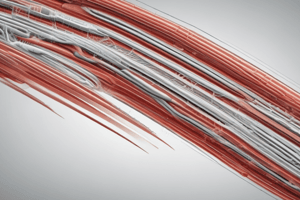Podcast
Questions and Answers
If a muscle cell's primary function is to contract and facilitate movement, which component within the muscle cell is directly responsible for this contraction?
If a muscle cell's primary function is to contract and facilitate movement, which component within the muscle cell is directly responsible for this contraction?
- Mitochondrion
- Myofibril (correct)
- Sarcoplasmic reticulum
- Sarcomere
During intense physical activity, muscles require a significant amount of energy. What is the primary source of immediate energy that muscle cells use to fuel their contractions?
During intense physical activity, muscles require a significant amount of energy. What is the primary source of immediate energy that muscle cells use to fuel their contractions?
- Fatty acids
- Glucose
- Amino acids
- Adenosine Triphosphate (ATP) (correct)
The human body uses lever systems to coordinate bones and muscles for movement. In a lever system, what is the primary purpose of generating muscular effort?
The human body uses lever systems to coordinate bones and muscles for movement. In a lever system, what is the primary purpose of generating muscular effort?
- To increase the speed of a given movement
- To overcome a given load (correct)
- To maintain posture and stability
- To reduce the amount of force required to move a load
Maintaining a stable body temperature is crucial for survival. Which of the following functions of muscle tissue directly contributes to thermoregulation?
Maintaining a stable body temperature is crucial for survival. Which of the following functions of muscle tissue directly contributes to thermoregulation?
Muscle tissue plays a role in several bodily functions. Which of the following is NOT a primary function of muscle tissue?
Muscle tissue plays a role in several bodily functions. Which of the following is NOT a primary function of muscle tissue?
The sarcomere is a fundamental unit within muscle tissue. What structural feature gives the sarcomere its characteristic appearance under a microscope?
The sarcomere is a fundamental unit within muscle tissue. What structural feature gives the sarcomere its characteristic appearance under a microscope?
Muscles account for a significant portion of a person’s body weight. Approximately what percentage of an average person’s weight is made up of muscle?
Muscles account for a significant portion of a person’s body weight. Approximately what percentage of an average person’s weight is made up of muscle?
Arrange the following in order from smallest to largest: muscle cell, myofibril, muscle tissue.
Arrange the following in order from smallest to largest: muscle cell, myofibril, muscle tissue.
Flashcards
Muscle Definition
Muscle Definition
Fibrous tissue in the body that can contract, producing movement or maintaining position.
Myofibril
Myofibril
The contractile thread of a muscle cell.
Sarcomere
Sarcomere
The basic structural unit of muscle, composed of fibrous proteins that slide past each other.
ATP's Role
ATP's Role
Signup and view all the flashcards
Functions of Muscle
Functions of Muscle
Signup and view all the flashcards
Lever Systems
Lever Systems
Signup and view all the flashcards
Lever Functions
Lever Functions
Signup and view all the flashcards
Heat for survival
Heat for survival
Signup and view all the flashcards
Study Notes
- Muscle accounts for 40% of a person's weight
Definition of Muscle
- Muscle is a band of fibrous tissue in a human or animal body
- Muscle tissue can contract, producing movement in or maintaining body position
Myofibril
- Muscle tissue comprises muscle cells
- Muscle cells consist of several myofibrils
- A myofibril is a contractile thread of a muscle
- Myofibrils extend from one end of the muscle fibre to the other
Sarcomere
- The sarcomere comprised of long fibrous proteins
- These proteins slide past each other
- The sliding of these proteins creates the appearance of dark and light bands when viewed via a microscope
- Sarcomeres are the basic structural unit of a muscle.
Muscle Fuel
- Muscle cells fuel their actions with chemical energy
- The chemical energy is in the form of Adenosine Triphosphate (ATP)
- ATP comes from the metabolism of food
Functions of Muscle
- Posture/Muscle Tone
- Stability
- Mobility/Movement
- Circulation
- Respiration
- Digestion
- Temperature Regulation/Heat Production
- Organ Protection
- Urination
First order levers
- Lever systems are the coordination of bones and muscles to create movement
- Muscles can generate muscular effort to overcome a given load
- Muscles increase the speed of a given movement
Heat Production
- Healthy survival depends on the ability to maintain a constant body temperature
Muscle Tone
- A state of sustained partial contraction of a muscle
Muscle Fatigue
- Muscle fatigue is caused by not enough oxygen and nutrients
- Muscle fatigue results from a build-up of waste products
Properties of Muscle Tissue
- Muscle cells share several properties:
- Contractility
- Excitability
- Extensibility
- Elasticity
Contractility
- Contractility is the ability of muscle to forcefully shorten
- For a muscle to work, one will need to flex and the other contract
- Muscles can only pull, never push
Excitability
- Excitability is the ability to respond to a stimulus
- The stimulus is delivered from a motor neurone or hormone
Extensibility
- Extensibility is the ability for a muscle to be stretched
Elasticity
- Elasticity is the ability for the muscle to recoil or bounce back to its original length after being stretched
Studying That Suits You
Use AI to generate personalized quizzes and flashcards to suit your learning preferences.
Related Documents
Description
Explore the structure and function of muscles, which make up 40% of body weight. Learn about myofibrils, sarcomeres, and the role of ATP in powering muscle contractions for posture, stability, movement, and essential bodily functions.




